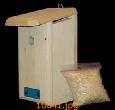The little
bird that speaks his name and does acrobatic stunts on tree branches
delights all bird watchers. This plump little fellow with the black
cap is friendly, and chances are he's been at your feeder in the
winter.
Chickadees
look for tree holes, either natural or made by woodpeckers, for their
nests. But if a tree is sufficiently soft or rotten, they may make
their own holes. A dead birch tree, which is rotten in the center,
is an ideal place for a chickadee nest.
Four
species of chickadee may be found in nesting boxes. The Black-capped
Chickadee (Poecile atricapilla) lives in all northern and most
middle states as well as in most of Canada. Its black cap and bib,
and white cheeks identify it, as does its "chick-a-dee-dee-dee"
call. The Carolina Chickadee (Poecile carolinensis), which looks
almost the same, lives in the southeast quarter of the US and has a
slightly higher, faster version of the call.
The
Mountain Chickadee (Poecile gambeli) has a white "eyebrow" through
its black cap and lives in and west of the Rocky Mountains, where he calls
"chick-adee-adee-adee". The Chestnut-backed Chickadee has a
chestnut-brown back and a brown cap and lives in the northwest and along
the California coast. His call is more of a
"tseek-a-dee-dee."
The
Black-capped and Carolina Chickadees like mixed forests, open woodlands
and suburban areas, while their western cousins prefer coniferous
forests.
Chickadee
belong to the titmouse family. They are largely an insect eaters,
but in winter they may depend greatly on seeds and berries. They are
adept at foraging for insect eggs and larvae from twigs and bark, and this
accounts for their active hopping and climbing around on trees to spot
their food from all angles! Their favorite foods at feeders are
sunflower seeds, peanut kernels, other nutmeats, peanut butter, and
suet.
In the
non-breeding season chickadees tend to flock together, and sometimes the
flock may even include titmice, kinglets, nuthatches, and other
birds. During breeding season, the males will drive others out of
their territories, so you may have only one pair of chickadees in your
yard, where you may have had a flock all winter.
From the
beginning of courtship through the period of egg incubation, the male
chickadee feeds the female. They typically raise one or two broods a
year of 6 to 8 young and are year-round residents.
Since
chickadees' natural means of nesting is to excavate a hole in a rotting
tree, you may make your nest box more attractive to them by putting a
little sawdust or wood chips inside it for them. They will not use it for
nesting, but since they usually work in pairs to carry a little sawdust
away from the hole they are making in a tree, they will perceive that this
"hole in a tree" is appropriate for them, and they will carry the sawdust
away before nesting there.
Chickadees
move to denser woods for breeding and nesting, but the rest of the year
they like open areas and forest edges.





 Coveside Chickadee House
Coveside Chickadee House
 Coveside Slate Squirrel Guard
Coveside Slate Squirrel Guard
 Coveside Wood Chips Nesting Material
Coveside Wood Chips Nesting Material Coveside Wood Predator Guard
Coveside Wood Predator Guard

 Woodside Gardens
The Registry of Nature Habitats
Woodside Gardens
The Registry of Nature Habitats 
 1999 -
1999 -